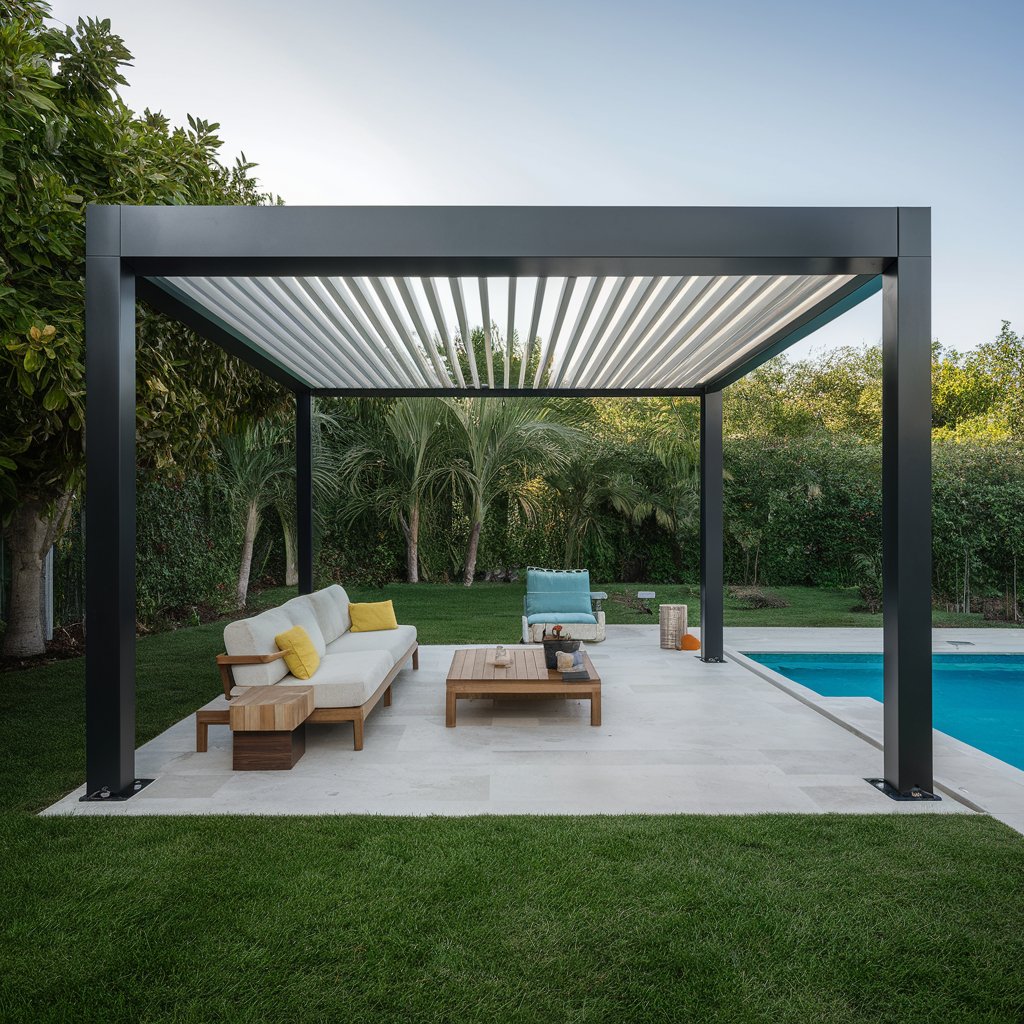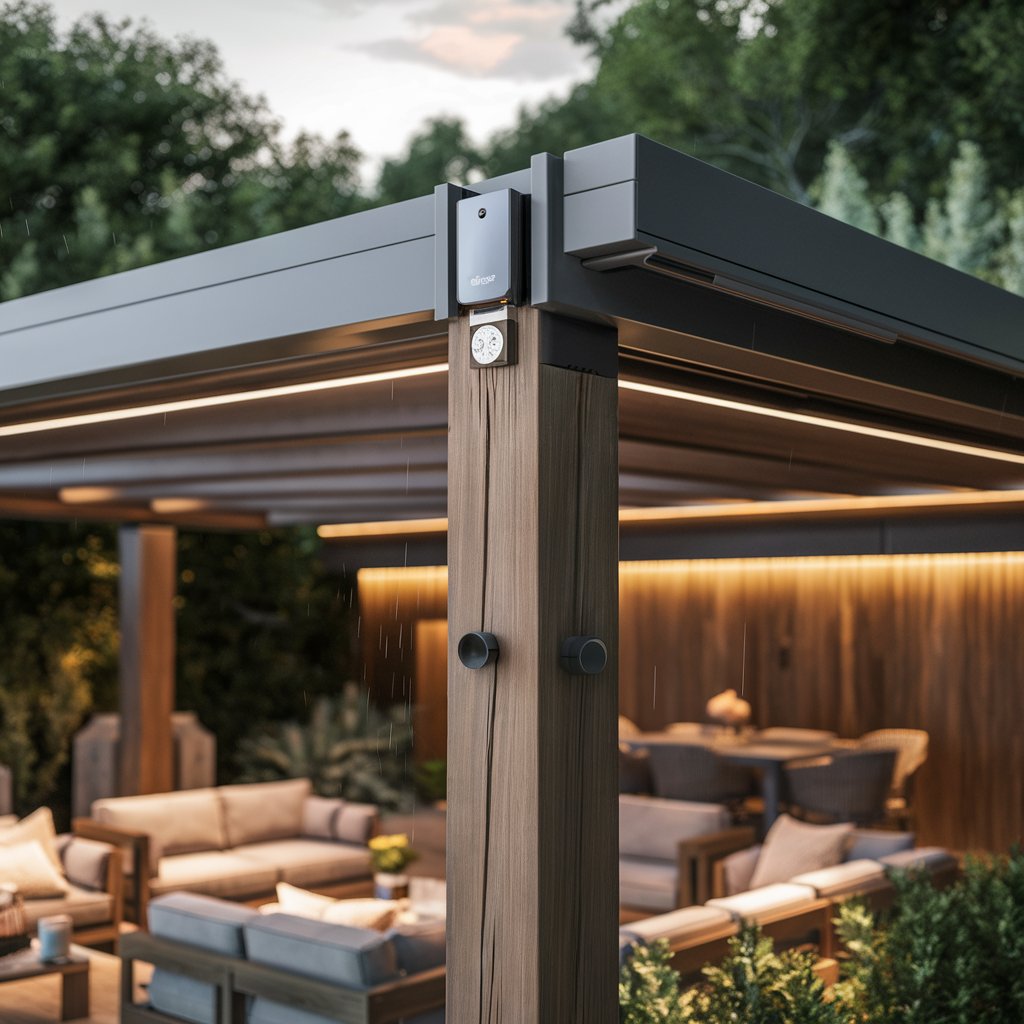Introduction
The concept of outdoor living has evolved dramatically over the past few decades. The desire for functional, comfortable, and aesthetically pleasing outdoor spaces has driven innovations in architectural designs and outdoor structures. One such innovation is the modern motorized louvered pergola. Combining technology, versatility, and style, these pergolas have become a popular choice for homeowners seeking to enhance their outdoor living experiences.

What is a Motorized Louvered Pergola?
A motorized louvered pergola is an outdoor structure featuring adjustable louvers that can be tilted to various angles. These louvers are typically operated by a motorized system, allowing for easy and convenient adjustment. The ability to control the louvers remotely provides users with the flexibility to manage sunlight, shade, ventilation, and protection from the elements.
Features of Modern Motorized Louvered Pergola
- Adjustable Louvers: The core feature of these pergolas is the adjustable louvers. These slats can be tilted from a fully open position, allowing maximum sunlight, to a fully closed position, providing complete shade and protection from rain. Intermediate positions offer varying degrees of light and ventilation.
- Motorized Operation: Modern systems are equipped with motors that control the movement of the louvers. This motorized operation can be managed via remote controls, smartphone apps, or integrated home automation systems. The convenience of motorized control enhances the user experience, allowing for effortless adjustments.
- Weather Sensors: Many advanced motorized pergolas come with integrated weather sensors. These sensors can detect changes in weather conditions, such as rain or high winds, and automatically adjust the louvers to protect the space and its occupants. For instance, the louvers can close when rain is detected, ensuring that the area beneath remains dry.
- Durable Materials: The materials used in the construction of motorized louvered pergolas are chosen for their durability and weather resistance. Aluminum is a popular choice due to its lightweight nature, resistance to rust and corrosion, and strength. Other materials like stainless steel, wood, and high-quality plastics are also used, depending on the design and manufacturer.
- Lighting and Accessories: To enhance the functionality and ambiance of the pergola, many systems offer integrated LED lighting, ceiling fans, infrared heaters, and other accessories. These additions make the outdoor space usable and comfortable at all times, regardless of the time of day or weather conditions.
Benefits of Modern Motorized Louvered Pergola
- Versatility: The ability to adjust the louvers provides unparalleled versatility. Users can control the amount of sunlight and shade, making the space suitable for a wide range of activities, from sunbathing to outdoor dining. The adaptability of the pergola allows it to cater to different needs throughout the day and across seasons.
- Weather Protection: By adjusting the louvers, users can create a sheltered space that offers protection from rain, wind, and harsh sunlight. This weather protection extends the usability of outdoor areas, allowing for enjoyment even in less-than-ideal weather conditions.
- Energy Efficiency: Motorized louvered pergolas can contribute to energy efficiency in homes. By managing the amount of direct sunlight that enters adjacent indoor spaces, the pergola can help regulate indoor temperatures. In the summer, closing the louvers can reduce heat gain, thereby lowering cooling costs. Conversely, opening the louvers in the winter can allow sunlight to warm the space, reducing heating costs.
- Aesthetics and Property Value: These pergolas add a modern and sleek look to outdoor areas, enhancing the overall aesthetic appeal of a property. The combination of form and function makes them a desirable feature for potential homebuyers, potentially increasing the property’s value.
- Low Maintenance: Due to the use of durable materials like aluminum and stainless steel, motorized louvered pergolas require minimal maintenance. The structures are designed to withstand harsh weather conditions without deteriorating, ensuring longevity and consistent performance with minimal upkeep.
Materials and Construction
The choice of materials in the construction of motorized louvered pergolas is critical to their performance and durability. The following are some commonly used materials:
- Aluminum: Aluminum is a preferred material for louvered pergolas due to its lightweight nature, resistance to rust and corrosion, and strength. It is also relatively easy to work with, allowing for sleek and modern designs. Aluminum pergolas are low-maintenance and can withstand various weather conditions.
- Stainless Steel: Stainless steel is another durable material used in pergola construction. It offers excellent strength and resistance to corrosion, making it suitable for coastal areas or regions with high humidity. Stainless steel components add to the longevity and robustness of the structure.
- Wood: While less common in motorized systems, wood can be used for the frame or decorative elements of the pergola. Treated hardwoods like teak, cedar, and redwood are popular choices due to their natural resistance to decay and insects. Wood adds a warm and traditional aesthetic to the pergola but requires more maintenance compared to metal options.
- High-Quality Plastics and Composites: These materials are sometimes used for louvers or other components. They offer good weather resistance, are lightweight, and can be manufactured in various colors and finishes. Composites can provide the look of wood without the associated maintenance.
Design Considerations
When planning the installation of a motorized louvered pergola, several design considerations must be taken into account:
- Size and Scale: The size of the pergola should be proportional to the outdoor space and the intended use. Whether covering a small patio or a large deck, the dimensions should be carefully planned to ensure functionality and aesthetic balance.
- Orientation: The orientation of the pergola relative to the sun’s path is crucial for maximizing its benefits. Positioning the louvers to optimize sunlight and shade throughout the day can enhance comfort and energy efficiency.
- Integration with Existing Structures: The pergola should harmonize with the existing architectural style of the home and landscape. Considerations include matching materials, colors, and design elements to create a cohesive look.
- Permits and Regulations: Depending on the location, installing a motorized louvered pergola may require building permits and adherence to local zoning regulations. It’s essential to check with local authorities and ensure compliance with all necessary codes and permits.
- Budget: The cost of a motorized louvered pergola can vary widely based on size, materials, features, and installation complexity. Establishing a budget and exploring options within that range can help in making informed decisions.
Installation Process
The installation of a motorized louvered pergola typically involves several steps, which may vary depending on the complexity of the design and the specific product. Here’s an overview of the general installation process:
- Site Preparation: The first step is preparing the installation site. This may involve leveling the ground, laying a foundation, or ensuring that the existing surface can support the pergola structure. Proper site preparation is essential for stability and longevity.
- Frame Assembly: The frame of the pergola is assembled and anchored to the ground or an existing structure. This frame serves as the support for the louvers and must be installed with precision to ensure structural integrity.
- Louver Installation: Once the frame is in place, the louvers are installed. This step involves attaching the louvers to the frame and connecting them to the motorized system. Proper alignment and secure attachment are crucial for smooth operation.
- Motor and Control System Setup: The motor and control system are installed and connected to the power source. This step includes programming the remote controls, smartphone apps, or integration with home automation systems. The weather sensors, if included, are also set up and calibrated.
- Testing and Adjustments: After installation, the pergola is thoroughly tested to ensure that the louvers operate smoothly and respond correctly to the control system. Any necessary adjustments are made to optimize performance.
- Finishing Touches: Finally, any additional features like lighting, fans, or heaters are installed. The pergola is inspected to ensure that all components are functioning correctly and that the overall structure meets the desired specifications.
Maintenance and Care
Maintaining a motorized louvered pergola is relatively straightforward, especially when using high-quality materials like aluminum or stainless steel. Here are some maintenance tips to keep the pergola in optimal condition:
- Regular Cleaning: Periodic cleaning is essential to remove dirt, debris, and any buildup on the louvers and frame. A mild detergent and water solution can be used for cleaning, followed by rinsing with clean water.
- Inspecting for Damage: Regularly inspect the pergola for any signs of damage, such as loose louvers, rust spots, or worn-out components. Addressing minor issues promptly can prevent more significant problems and extend the lifespan of the pergola.
- Lubricating Moving Parts: The motorized components and any moving parts should be lubricated periodically to ensure smooth operation. Use appropriate lubricants as recommended by the manufacturer.
- Checking the Control System: Ensure that the remote controls, smartphone apps, and home automation integrations are functioning correctly. Replace batteries in remote controls as needed and update software or apps to the latest versions.
- Weather Sensor Maintenance: If the pergola is equipped with weather sensors, these should be checked and cleaned regularly to ensure accurate readings and proper functioning.
- Professional Inspections: Consider having a professional inspection periodically, especially if the pergola is in a region with extreme weather conditions. A professional can identify potential issues and provide maintenance services to keep the pergola in top condition.
Conclusion
Modern motorized louvered pergolas represent a perfect blend of technology, functionality, and style. They provide a versatile outdoor living space that can be adapted to different weather conditions and user preferences. With features like adjustable louvers, motorized operation, and integrated accessories, these pergolas enhance the comfort and usability of outdoor areas. The use of durable materials and thoughtful design ensures longevity and minimal maintenance.
Investing in a motorized louvered pergola can transform an outdoor space into a comfortable, stylish, and functional area for relaxation, entertainment, and enjoyment. Whether for a residential property or a commercial space, these pergolas offer a modern solution to outdoor living, combining innovation with timeless appeal.
4o


